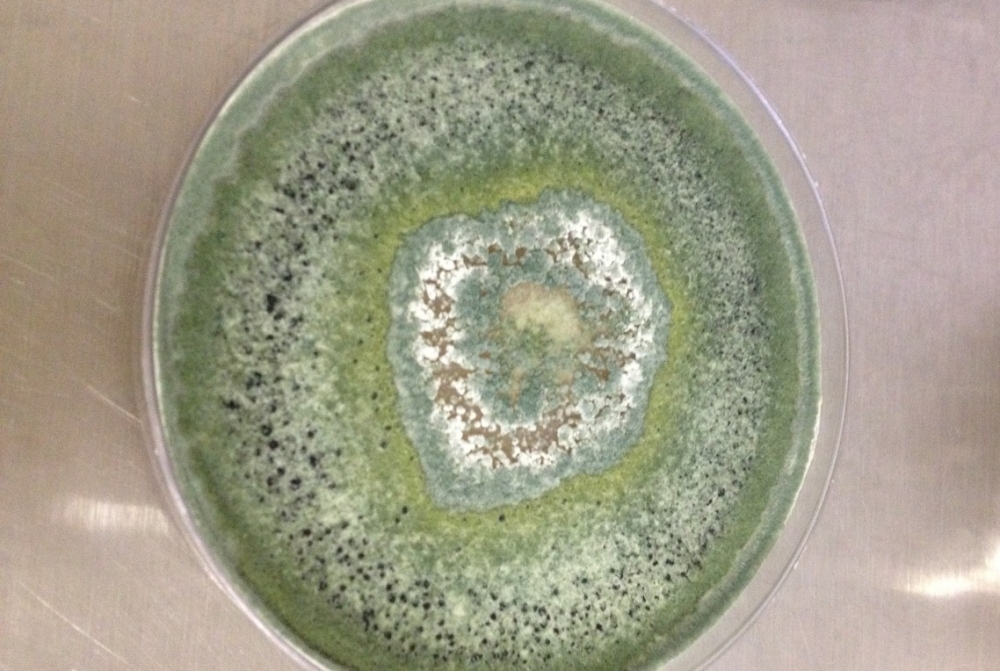


The molecule described by Brazilian researchers in the journal Scientific Reports acts on different sugars present in several sources of plant biomass, making it attractive to other industries as well (fungus of the species Trichoderma harzianum; photo: Maria Augusta C. Horta/UNICAMP)
Published on 08/16/2021
By Maria Fernanda Ziegler | Agência FAPESP – Researchers at the State University of Campinas (UNICAMP) in Brazil have found an enzyme from the Amazon fungus Trichoderma harzianum to be capable of breaking down biomass. Fungi of the genus Trichoderma are present in most soil types and are the most prevalent culturable fungi. The researchers characterized the enzyme, and used genetic engineering techniques to mass produce it at low cost and make its industrial use viable.
The discovery is reported in an article published in the journal Scientific Reports. It will contribute to wider use of sugarcane waste to produce biofuels, as the development of a low-cost enzyme cocktail is one of the main challenges in the production of second-generation ethanol (derived from cane bagasse and trash).
“The enzyme breaks down different sugars present in various sources of plant biomass, making it highly versatile and interesting not only for the production of second-generation ethanol but also for use in the food and cosmetics industries, for example,” said Maria Lorenza Leal Motta, a researcher at UNICAMP’s Center for Molecular Biology and Genetic Engineering (CBMEG) and first author of the article.
The study was conducted during Motta’s research for a master’s degree with a scholarship from CAPES, the Ministry of Education’s Coordination for the Improvement of Higher Education Personnel, and support from FAPESP for the search for fungi that break down cellulosic substrates and promote the generation of free sugars, which can be used to produce biofuels.
Novel prospecting strategy
Besides the discovery of a novel enzyme for use in producing second-generation ethanol, the group has also developed innovative solutions for cellulose degradation. “For years we’ve been developing a methodology to prospect for these fungi involving evolution, gene expression and genomics. This makes our work more assertive, creating a sort of treasure chest of relevant information about enzymes with the potential for use by industry,” Anete Pereira de Souza, last author of the article, told Agência FAPESP. Souza is a professor at UNICAMP’s Institute of Biology, and Motta’s thesis advisor.
The prospection methodology involves studies of the evolution of fungal strains associated with different tools for analyzing genetic variations, genes, proteins and metabolites. “It’s a novel approach that lets us use several filters until we arrive at a candidate worth studying,” Souza said.
The researchers have also shown that Trichoderma fungi are potential candidates for the production of carbohydrate-active enzymes (CAZYmes), which degrade plant cell walls, including members of several glycoside hydrolase families.
According to Souza, almost all the biomass-degrading enzymes used in Brazil are imported and developed for deployment in the northern hemisphere. “Prospecting our own country’s biodiversity for these types of enzyme offers many advantages for ethanol production in terms of cost saving and efficiency gains. A fungus from the Amazon is likely to be better adapted to degrade biomass cellulose in a context such as ours,” she said.
Mass production
In the study that led to their discovery of the novel enzyme, the researchers used different strains of the fungus, sequenced their transcriptome (the set of all RNA transcripts in a population of cells), and analyzed their functional properties. Bioinformatics and biotechnology enabled them to produce the enzymes in Escherichia coli bacteria.
According to Motta, they selected the GH54 glycoside hydrolase family because it contains enzymes capable of acting synergistically with others and carrying out hydrolysis of different substrates, in addition to cell wall polysaccharides such as arabinose and xylose, and had not previously been studied in depth. “Our characterization of the enzyme revealed several physicochemical qualities that could be important for industry and weren’t previously known for this family. Other molecules in the family that haven’t been explored very much may have similar properties,” she said.
Among the properties they identified is the capacity to act on sugars in side chains of hemicellulose, a complex polysaccharide that occupies the spaces between cellulose fibrils in plant cell walls and is hard to degrade. “The enzyme, produced faster and more cheaply in the laboratory using E. coli, displayed activity on different sugars [galactopyranoside, arabinopyranoside and fucopyranoside] present in the side chains surrounding the central portion of the hemicellulose. This shows that a cocktail of enzymes comprising different types of enzyme, especially those that remove the side chains, could enhance the efficiency of hemicellulose conversion and hence of cane bagasse and trash for second-generation ethanol,” Motta said.
Enzymes that act on the main chain of hemicellulose, such as beta-xylanases and endo-beta-xylanases, can access it only if the side chains are removed first. “In ethanol production, this novel enzyme can help enhance the conversion of hemicellulose to glucose for fermenting, which makes it highly interesting in commercial terms,” she explained.
Besides the capacity to act on different substrates, the enzyme has a number of biochemical qualities that make it potentially useful in industrial processes. “It acts in a wide range of pH values [5-9] and temperatures [40 °C-65 °C], and even so its relative activity remains above 50%,” she said. “This is interesting because pH and temperature vary considerably in many industrial processes, such as fermentation for the production of ethanol, for example.”
Another interesting feature of the enzyme is metal dependency, meaning that it requires a metal ion cofactor to exert its catalytic activity. “We found that magnesium ions most influenced its activity, which may be because they maintain the stability of the enzyme’s catalytic site,” Motta said.
The article “A novel fungal metal-dependent α-L-arabinofuranosidase of family 54 glycoside hydrolase shows expanded substrate specificity” (doi: 10.1038/s41598-021-90490-2) by Maria Lorenza Leal Motta, Jaire Alves Ferreira Filho, Ricardo Rodrigues de Melo, Leticia Maria Zanphorlin, Clelton Aparecido dos Santos and Anete Pereira de Souza is at: www.nature.com/articles/s41598-021-90490-2.
Source: https://agencia.fapesp.br/36489